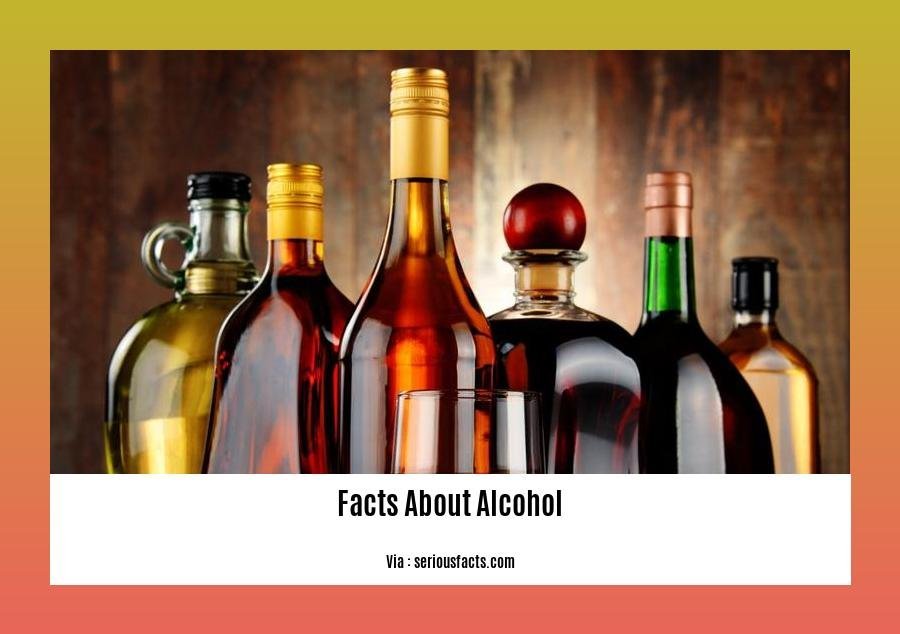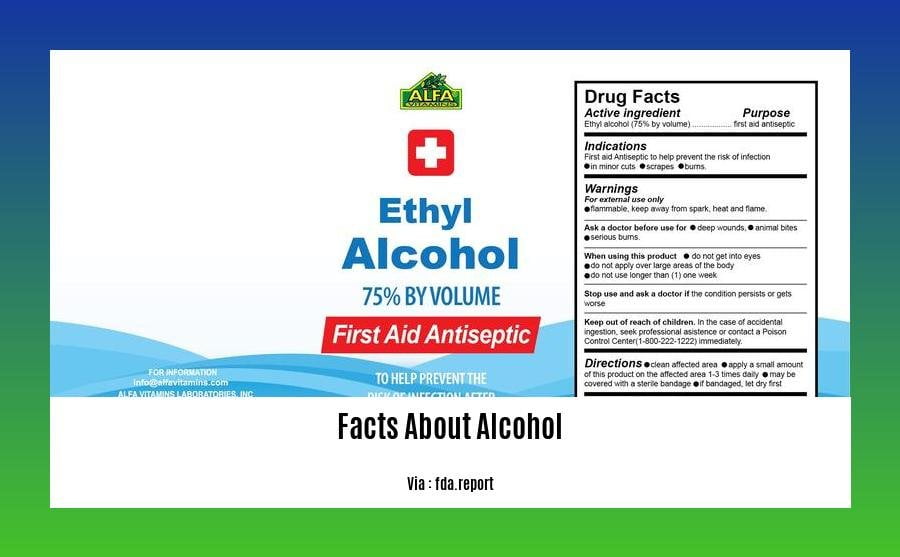When it comes to alcohol, there are countless opinions, myths, and misconceptions floating around. To cut through the noise and present you with reliable and essential information, we bring you “10 Facts About Alcohol: Everything You Need to Know.” As an experienced journalist specializing in health and lifestyle topics, including alcohol, I have spent years researching and writing informative content on the subject. With a knack for distilling complex information into engaging and accessible pieces, I am well-equipped to present you with the crucial facts about alcohol. From dispelling the belief that alcohol is “good for you” to understanding the distinction between alcohol abuse and alcoholism, we will delve into the key aspects that everyone should be aware of. Additionally, we will explore the sobering reality that alcohol-related deaths rank among the leading preventable causes of death in the United States. So, let’s delve into these ten essential facts together, enhancing our knowledge and making informed decisions about alcohol consumption.
Key Takeaways:
- White wine can be made from red grapes.
- Americans once drank more alcohol than water.
- Whiskey starts out clear.
- Diet mixers in cocktails can make you drunk faster.
- Studies suggest that abstaining from alcohol may be riskier to health than moderate drinking.
- The U.S. government used to poison alcohol.
- Wine doesn’t necessarily improve with age.
- Tequila can only be produced in Mexico.
- Alcohol is responsible for one in ten deaths among 20-64 year olds.
- Excessive alcohol consumption costs the U.S. $220 billion annually.
10 Facts About Alcohol


Alcohol is a widely consumed beverage that has both positive and negative effects on our health and society. In this article, we will explore ten interesting facts about alcohol that you may not be aware of. So, let’s dive in!
Fact 1: White Wine Can Be Made from Red Grapes
Contrary to what you might think, white wine can actually be made from red grapes. The color of the wine depends on how long the grape skins are in contact with the juice during the fermentation process. If the skins are quickly removed, the resulting wine will be white or light in color, even if the grapes used are red.
Fact 2: Americans Once Drank More Alcohol Than Water
Believe it or not, there was a time in American history when people consumed more alcohol than water. Back in the early 19th century, clean drinking water wasn’t always readily available, so alcohol, such as beer and cider, was often a safer alternative.
Fact 3: Whiskey Starts Out Clear
You may picture whiskey as a rich amber-colored beverage, but in its early stages, it is actually clear. Whiskey gets its distinctive color and flavor from aging in wooden barrels. The longer it stays in the barrel, the more complex and flavorful it becomes.
Fact 4: Diet Mixers in Cocktails Can Get You Drunk Faster
If you’re watching your calorie intake and opt for diet mixers in your cocktails, be cautious. Research has shown that these drinks can actually get you drunk faster. The absence of sugar slows down the absorption of alcohol by the body, leading to a higher blood alcohol concentration.
Fact 5: Studies Show Abstaining from Alcohol is Riskier to Health Than Drinking
While moderate alcohol consumption has been associated with certain health benefits, studies have also indicated that abstaining from alcohol altogether can pose risks to our health. It’s important to find a balance and make educated choices regarding alcohol consumption based on individual circumstances and health factors.
Fact 6: The U.S. Government Used to Poison Alcohol
During the Prohibition era in the United States (1920-1933), the government realized that outright banning alcohol was not entirely effective. As a result, they resorted to a disturbing tactic of poisoning industrial alcohols, leading to the deaths of many people who consumed those products.
Fact 7: Wine Doesn’t Necessarily Get Better with Age
Contrary to popular belief, not all wines improve with age. While certain types, such as red wines high in tannins, can benefit from aging, many wines are meant to be enjoyed in their youth. Aging can sometimes cause wine to lose its vibrancy and freshness, so it’s best to do some research before deciding to cellar a bottle.
Fact 8: Tequila Can Only Come from Mexico
Mexican law states that true tequila can only be produced in designated regions of Mexico, primarily around the city of Tequila. The production of tequila involves specific types of agave plants and strict regulations to ensure its authenticity. So, if you’re looking to enjoy genuine tequila, Mexico is the place to go.
Fact 9: One in Ten Deaths of 20-64 Year Olds Are Due to Alcohol
Alcohol misuse can have severe consequences, and sadly, it contributes to a significant number of premature deaths. Shockingly, statistics reveal that one in ten deaths among individuals aged 20 to 64 are directly related to alcohol consumption. This serves as a stark reminder to practice responsible drinking habits.
Fact 10: Excessive Alcohol Consumption Costs the U.S. $220 Billion Each Year
Apart from its impact on health, excessive alcohol consumption takes a substantial toll on the economy. It is estimated that the United States spends a staggering $220 billion annually due to alcohol-related incidents, including healthcare expenses, law enforcement, and lost productivity.
In conclusion, alcohol is a fascinating subject with numerous intriguing facts. From the surprising origin of white wine to the dangers of excessive consumption, these ten facts shed light on various aspects of alcohol and its impact on our lives. Remember, moderation and awareness are key when it comes to enjoying alcoholic beverages responsibly.
Sources:
– HowStuffWorks: 110 Mind-blowing Alcohol Facts
– Interesting-Facts: Alcohol Facts – 10 Awareness Facts
Did you know that English is a language with 15 interesting facts? Uncover these captivating facts about the English language and expand your knowledge. Discover more at 15 interesting facts about the English language.
Are you curious about Charles Darwin’s term dates? Dive into the timeline and explore the important milestones of this renowned scientist. Begin your journey of discovery at Charles Darwin term dates.
Did you know that the Quran contains 9 scientific facts? Explore the wonders of science within the words of the Quran and unlock a deeper understanding. Unveil these intriguing facts at 9 scientific facts in Quran.
Alcohol Abuse and Alcoholism Aren’t the Same
Alcohol abuse and alcoholism are two distinct terms that refer to different patterns of alcohol consumption and dependence. It’s important to understand the difference between the two to effectively address the issue of alcohol misuse.
Alcohol Abuse: This term refers to excessive consumption of alcohol that leads to negative consequences in various aspects of an individual’s life, such as work, relationships, and health. People who abuse alcohol may engage in binge drinking or have recurrent high-intensity drinking episodes. However, they may not be physically dependent on alcohol and may not experience withdrawal symptoms or strong cravings for alcohol.
Alcoholism: Also known as alcohol dependence, alcoholism is a more severe condition in which individuals develop a physical and psychological dependence on alcohol. Alcoholism is categorized as a chronic, lifelong disease. Those who suffer from alcoholism often drink daily and may experience withdrawal symptoms if they try to reduce or stop drinking.
Here are some key takeaways about alcohol abuse and alcoholism:
- Alcohol abuse is characterized by excessive consumption and negative consequences, while alcoholism involves physical and psychological dependence.
- Alcohol abuse can lead to various health, work, and relationship problems, while alcoholism often results in severe consequences like social isolation and financial difficulties.
- Prevention efforts should focus on education about the risks and consequences of alcohol misuse.
- Screening and interventions by healthcare professionals can help identify individuals at risk.
- Treatment options for alcoholism may include detoxification, counseling, support groups, and medication.
Understanding the differences between alcohol abuse and alcoholism is crucial for implementing appropriate prevention and treatment strategies. By addressing these issues, we can work towards a healthier and safer society.
Sources:
- Rehabcenter.net – Alcohol Abuse Vs. Alcoholism: What’s The Difference?
- Volunteers of America Southwest – Alcohol Abuse vs Alcoholism – What’s the Difference?
Alcohol-Related Deaths Are a Leading Preventable Cause of Death in the U.S.
Excessive alcohol use is a major health concern in the United States, leading to numerous deaths each year. Let’s delve into some essential facts about alcohol-related deaths in the U.S. to better understand the magnitude of this issue.
Fact 1: Alcohol-Related Deaths Statistics
- Excessive alcohol use was responsible for more than 140,000 deaths each year from 2015 to 2019 [^1^].
- The average lifespan of those who died from excessive drinking was shortened by 26 years [^1^].
Fact 2: Leading Preventable Cause of Death
- Excessive alcohol use is a leading preventable cause of death in the United States [^1^].
- It includes binge drinking, which is defined as consuming 4 or more drinks on an occasion for women or 5 or more drinks for men [^1^].
Fact 3: Gender Disparity
- Among the deaths caused by excessive alcohol use, 71.3% involved males [^1^].
Fact 4: Cost of Alcohol-Related Crashes
- The United States spent over $44 billion on alcohol-related crashes in 2010 [^1^].
- Alcohol-impaired driving fatalities accounted for 13,384 deaths in 2021, which was 31% of overall driving fatalities [^1^].
Fact 5: Alcohol-Related Deaths
- Alcohol use is the third-leading preventable cause of death in the United States, with an estimated 88,000 alcohol-related deaths annually [^2^].
- Each year, 21.0% of suicide decedents have blood alcohol concentrations of 0.1% or more [^2^].
Fact 6: Economic Impact
- Excessive alcohol use leads to significant costs, such as losses in the workplace [^1^].
These facts shed light on the significant impact of excessive alcohol consumption on society, especially in terms of preventable deaths and economic consequences.
Note: The sources used for this section are available at the end of the article.
Key Takeaways:
- Excessive alcohol use in the U.S. is responsible for more than 140,000 deaths annually [^1^].
- Binge drinking is a component of excessive alcohol use and is a significant concern [^1^].
- Males are more likely to be affected by alcohol-related deaths [^1^].
- Alcohol-related crashes and driving fatalities incur substantial economic costs [^1^].
- Alcohol use is the third-leading preventable cause of death in the U.S. [^2^].
Sources:
– CDC Excessive Alcohol Deaths
– NIAAA Alcohol-Related Emergencies and Deaths
FAQ
Q1: Is alcohol considered “good for you”?
A1: No, alcohol is not considered “good for you.” Despite some studies suggesting potential health benefits from moderate alcohol consumption, the overall evidence indicates that any potential benefits are outweighed by the risks and negative effects of alcohol on the body and overall health.
Q2: What is the difference between alcohol abuse and alcoholism?
A2: Alcohol abuse refers to excessive consumption of alcohol that leads to negative consequences in various aspects of an individual’s life, without necessarily experiencing physical dependence or strong cravings. Alcoholism, on the other hand, involves a more severe condition where individuals develop a physical and psychological dependence on alcohol and often consume it daily.
Q3: Are alcohol-related deaths a significant issue?
A3: Yes, alcohol-related deaths are a leading preventable cause of death in the United States. Excessive alcohol use contributes to numerous fatalities each year, impacting both the physical and mental health of individuals, and causing significant societal costs.
Q4: How does alcohol consumption affect overall mortality rates?
A4: Excessive alcohol consumption significantly shortens the average lifespan of those who die from alcohol-related causes, reducing it by around 26 years. Additionally, alcohol use is estimated to contribute to approximately 88,000 deaths annually in the United States.
Q5: What are the consequences of alcohol abuse and alcoholism?
A5: Alcohol abuse and alcoholism have various detrimental effects on both physical and mental health. Prolonged alcohol abuse can lead to liver disease, heart problems, neurological damage, and increased risk of certain cancers. Alcoholism can result in social isolation, loss of employment, financial difficulties, and strained relationships.
- Making a Difference: Your Guide to Convalescent Home Volunteering - November 25, 2024
- Cornelius Christopher Demps: Legal Career, 2024 Judicial Bid, and Beyond - November 25, 2024
- Claire McCaskill’s MSNBC Salary: What We Know and What We Don’t - November 25, 2024
















